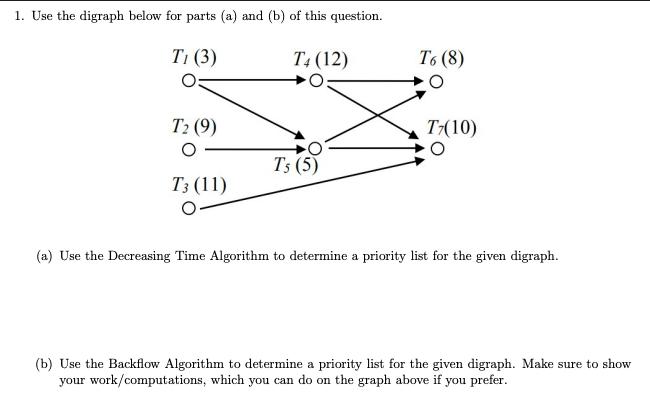Answered step by step
Verified Expert Solution
Question
1 Approved Answer
1. Use the digraph below for parts (a) and (b) of this question. T (3) T2 (9) O T3 (11) T4 (12) Ts (5)

1. Use the digraph below for parts (a) and (b) of this question. T (3) T2 (9) O T3 (11) T4 (12) Ts (5) T6 (8) IXI T7(10) (a) Use the Decreasing Time Algorithm to determine a priority list for the given digraph. (b) Use the Backflow Algorithm to determine a priority list for the given digraph. Make sure to show your work/computations, which you can do on the graph above if you prefer. 1. Use the digraph below for parts (a) and (b) of this question. T (3) T2 (9) O T3 (11) T4 (12) Ts (5) T6 (8) IXI T7(10) (a) Use the Decreasing Time Algorithm to determine a priority list for the given digraph. (b) Use the Backflow Algorithm to determine a priority list for the given digraph. Make sure to show your work/computations, which you can do on the graph above if you prefer. 1. Use the digraph below for parts (a) and (b) of this question. T (3) T2 (9) O T3 (11) T4 (12) Ts (5) T6 (8) IXI T7(10) (a) Use the Decreasing Time Algorithm to determine a priority list for the given digraph. (b) Use the Backflow Algorithm to determine a priority list for the given digraph. Make sure to show your work/computations, which you can do on the graph above if you prefer.
Step by Step Solution
★★★★★
3.46 Rating (153 Votes )
There are 3 Steps involved in it
Step: 1

Get Instant Access to Expert-Tailored Solutions
See step-by-step solutions with expert insights and AI powered tools for academic success
Step: 2

Step: 3

Ace Your Homework with AI
Get the answers you need in no time with our AI-driven, step-by-step assistance
Get Started


